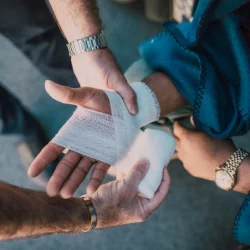5 Things To Do After Your Personal Injury Claim Has Been Denied
We take on insurance plans because we’re always keenly aware that all it takes is one accident, one mishap, one unfortunate injury for our lives get turned upside down. Our insurance plans are supposed to protect us from that small chance that things go wrong. Insurance is there to give our lives some semblance of order amidst a chaotic period.
But what happens when your safety net fails? What happens if instead of protecting you, the insurance plan you took on previously is the very thing causing you undue stress during an already trying time?
As difficult as it may be in that kind of situation, you have to be proactive.
In this article, we will run down the five things you must do in the event that your insurance company denies your personal injury claim.
Step 1: Find Out Why Your Claim Was Denied
Before you do anything else of significance, the first step you must take following the denial of your claim is to sit down and try to understand why that happened.
Your insurance company has likely sent you a letter detailing their reasons for the denial so pore over it as best as you can and try to see things from their perspective.
Once you’ve looked over the denial letter, take out your insurance policy and check to see if their reasons are consistent with the agreement you signed up for. Perhaps there was a loophole you didn’t notice earlier that they are exploiting or maybe you were just not fully aware of your plan in the first place.
The insurance company may use to deny your claim include: the filing of a supposedly incorrect claim, a failure on your part to get treated right away, you not doing enough to avoid the injury, a pre-existing condition, or a lack of documents. They may also claim that your plan does not cover your specific injury, or that the accident in question was not even responsible for your injury.
If there is something you missed and their reasons line up with that, then it may be time to accept the denial.
However, if things aren’t adding up, it’s time to move to the next step of your response.
Step 2: Contact Your Insurance Provider Via a Dispute Letter
After you’ve determined that your insurance provider was mistaken in denying your personal injury claim, it’s time to move ahead with your response by writing a dispute letter.
Penning the dispute letter is a hugely important part of your response. Within that dispute letter, you need to detail every inconsistency and mistake that you spotted in their denial letter. If there are bits of false information scattered throughout the denial letter, do not hesitate to highlight them as well.
You must be as thorough as possible in your dispute letter to make it clear to your insurance provider that you believe they made a mistake.
Step 3: Wait Them Out
This is probably going to be the toughest part of the process for you because you will likely feel helpless quite often while carrying this out.
The next step involves waiting and plenty of it.
Even if you astutely point out the mistaken reasons used by your insurance provider in denying your claim, you still can’t count on them responding a day later and just making everything right.
Sadly, that’s not how this works.
What they may do instead is to drag this matter out by either saying they will investigate your claims but taking their sweet time doing so or by just flat out ignoring your dispute letter.
You obviously have to give them time to respond, but it’s tough not knowing exactly when they may take action or even if they are planning to.
The best thing you can do at this point is to continue waiting. But, if your insurance provider has still not done anything after a significant amount of time has passed and you know that you’re running up against the statute of limitations, it would be best for you to take the next step.
Step 4: Find and Hire a Personal Injury Lawyer
It sure seems like your insurance provider is not taking you very seriously. You can change that by getting a lawyer involved.
In the past, the process of finding a personal injury lawyer was more complicated and time-consuming because not everyone knew where to look for them.
Thankfully, the search is much easier now. You can quickly check online for a personal injury lawyer and probably find one near your area.
For residents of Western Australia for instance, they can head over to Foylelegal.com to seek counsel regarding their claims.
Obviously, you still need to make sure that the lawyer you’re hiring is reputable and capable of effectively fighting for your cause. To find out more about that, go ahead and check out some ratings and reviews online to see if the personal injury lawyer you’re looking to hire will be able to put in good work.
Step 5: Attend the Arbitration Hearing or File a Lawsuit
There’s a chance that your insurance provider may end up responding to your dispute letter by setting up an arbitration hearing.
According to AskRobertWhite.com, these hearings often end up favouring the insurance provider. That’s why you must hire a personal injury attorney before you take part in that hearing.
Now, if the insurance company still declined to set up a hearing, you must take the initiative again by filing a lawsuit. Make it clear in the lawsuit that your insurance provider did not follow the terms of the agreement you signed up for.
With the lawsuit filed, you will now have to wait for the justice system to spring into action and hope that things turn out in your favour.
Conclusion
The last thing you want to deal with in the aftermath of sustaining a significant injury is an issue involving your insurance provider, but sometimes, that is just inevitable.
To make the ordeal easier to manage, call upon a personal injury lawyer and ask for some assistance. After you do that, you can expect this unfortunate matter to be handled in proper fashion.
More to Read:
Previous Posts:




